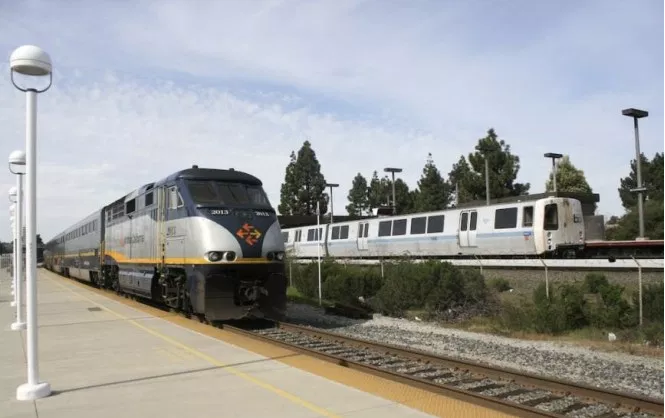Note: GJEL Accident Attorneys regularly sponsors coverage on Streetsblog San Francisco and Streetsblog California. Unless noted in the story, GJEL Accident Attorneys is not consulted for the content or editorial direction of the sponsored content.
It could take twenty years and more and $15 billion to build the underwater tunnel to make it possible, but one day riders may be able to board an Amtrak train in Sacramento and ride all the way to San Francisco's Transbay Transit Center--and then directly through to the cities of the Peninsula.
BART received bids yesterday from firms vying to begin planning for a second Transbay crossing. "The consultancy team will be comprised of people who will do program management and strategic advising on this effort," said David Kutrosky, Managing Director of the Capitol Corridor Joint Powers Authority, which oversees Amtrak's services on the 170-mile rail corridor between the State Capitol and San Jose.
Kutrosky is involved because, for one, BART is the managing agency for the Capitol Corridor. And because the plan is not only to build a tunnel for BART, but also for standard-gauge trains such as Caltrain, high-speed rail, and Amtrak. "There will be two different guideways that will be involved, one for conventional rail, one for BART," added Kutrosky in a phone interview with Streetsblog.
How many tracks will there be overall in the new tunnels? "We’re looking at all options, as to whether it’s another BART crossing or just a standard gauge or a combination... we need to do due diligence and full analysis and that’s what we’re doing over the next couple of years."
In addition, BART and the Capitol Corridor Joint Powers Authority will be working together to do public outreach and research to figure out exactly where the new crossing will be built.
Bay Area transit advocates, meanwhile, were happy to learn this vital project is moving forward. "Linking Caltrain and the Capitol Corridor line under the Bay via the Transbay Transit Center is a potentially transformative project that can connect dozens of underserved Bay Area communities with high-quality rail service, and link up Northern California," wrote Tom Radulovich, former head of the BART Board and director of Livable City, in an email to Streetsblog.
Currently, the only way for someone to ride a Capitol Corridor Amtrak train from Sacramento to San Francisco is to transfer to BART at Richmond Station, as pictured in the lead photo, or to take a bus or ferry across the Bay.
This, of course, is time-consuming. It's even worse for someone trying to reach the Peninsula since it means staying on BART all the way to Millbrae and then transferring again to Caltrain. A second tube that can carry standard-gauge trains would make that all a much faster, one-seat ride. "We absolutely should be starting to plan as a state and a region for the second Transbay rail connection," said Beaudry Kock of Seamless Bay Area, a group that advocates for better-integrated transit services.
But, as mentioned, that connection is still decades off. In the meantime, Kock and others said the Capitol Corridor needs to get integrated in other ways. "Capitol Corridor should absolutely get on board with Clipper," the Bay Area's fare-payment card system, he said.
Right now, passengers on a Capitol Corridor train can purchase a pre-loaded Clipper card in the cafe car to use at the BART fare gates or on the ferry, Muni, and on other agencies that connect to it. The one place they can't use Clipper: on the Capitol Corridor itself.
According to Kutrosky, the Capitol Corridor is working on fare integration with other Bay Area transit services, although the intention is to skip ahead of Clipper's plastic card and go directly to "a mobile app that can be used by any and all people traveling on the three intercity passenger rail services. It will replace the Amtrak ticketing program."
Meanwhile, Capitol Corridor trains have some of the same challenges as Caltrain--both are pulled by diesel locomotives that can't run into a long tunnel because of the fumes they produce. That's partly why Caltrain is electrifying (other reasons include better acceleration and cleaner operations) in anticipation of eventually running directly into downtown San Francisco via the downtown extension tunnel to the Transbay Transit Center.
But unlike Caltrain, the Capitol Corridor doesn't own the tracks it runs on. Unfortunately, "electrification is not acceptable to our host railroad, so we need to figure that out," said Kutrosky, adding that Union Pacific is concerned about clearances with overhead wire and their double-stack freight trains (although this problem is apparently solvable). Either way, Kutrosky said they might consider using dual-mode locomotives, such as those used by New Jersey Transit, which can run on diesel or overhead electric wire, as a way to bring trains into a future tunnel under the Bay.
New tracks through the East Bay, shared with Caltrain and HSR, could also be in the cards.
In the meantime, the Capitol Corridor is studying traffic demand and looking at acquiring more rolling stock, increasing speeds, and adding services. "Ten years out we assume we’ll have a higher level of frequency," said Kutrosky. But "is it a train every twenty, thirty, or every fifteen minutes?"
Achieving that will require upgrades and investments in rail infrastructure throughout the Bay Area. "The region’s rail network is antiquated, poorly connected, unresilient, and strained to the breaking point," said Radulovich. "We deserve better."
Radulovich added that the Bay Area's umbrella planning agency, the Metropolitan Transportation Commission, will have to take a lead role in making that better system happen. "I’m hoping that Therese McMillan [its newly appointed head] will shake the MTC of its institutional aversion to planning and strategic thinking, and revive regional rail planning."
"We should absolutely be upgrading the Capitol Corridor, whether or not we are able to connect directly into San Francisco," said TransForm's Stuart Cohen. "There are low-hanging fruit like Clipper integration and bypasses that can make trips simpler and more reliable."






